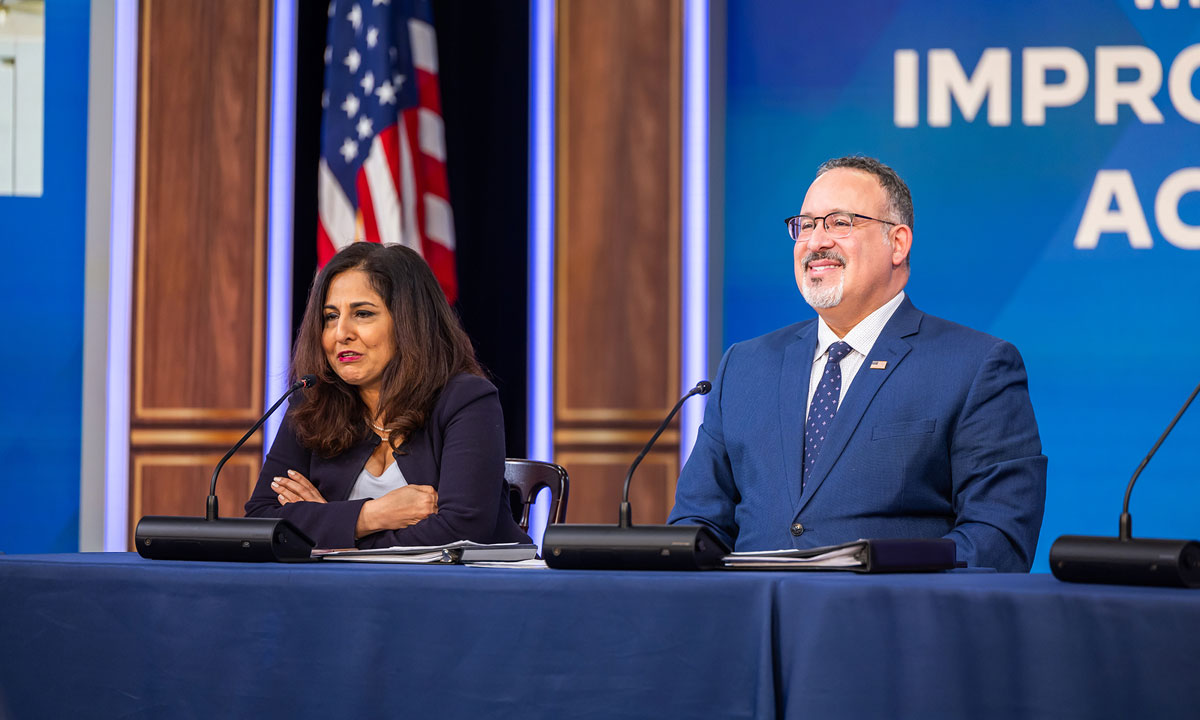Experts Give Biden High Marks on Student Achievement Agenda. But What About Parents?
While tutoring, chronic absenteeism and extra-learning time are shared priorities, some point to an “urgency gap” between educators and parents.

Get stories like this delivered straight to your inbox. Sign up for The 74 Newsletter
The Biden administration received high marks for elevating key strategies to help students rebound from pandemic learning loss — addressing chronic absenteeism, offering high-impact tutoring and extending learning afterschool and during the summer.
“These three strategies have one central goal — giving students more time and more support to succeed,” U.S. Education Secretary Miguel Cardona said Wednesday at a White House gathering to outline the president’s K-12 agenda. “We’ll use all the tools at our disposal to advance these three pillars.”
The event, featuring three governors and three state chiefs, highlighted successful efforts to spend pandemic relief funds on proven models, like home visits in Connecticut to improve student attendance and the New Jersey Tutoring Corps that now reaches 245 of the state’s 600 districts. The administration aims to make sure more states and districts are implementing effective programs.
But some feel there was scant attention to the role of families in such efforts.
“Amidst all the happy talk, there was no mention that far too many families seem unconvinced that they need to send students to school regularly, or to engage in additional learning opportunities,” said Nat Malkus, a senior fellow at the conservative American Enterprise Institute. The “supply side” of the equation — offering extra opportunities for learning — won’t make any difference if parents don’t see the value, he said.
Since the pandemic, researchers have documented a disconnect between parents and educators over pandemic learning loss. A University of Southern California study released in December documented what some have called an “urgency gap,” with parents expressing little alarm over long-term effects of school closures.
Keri Rodrigues, president of the National Parents Union, said there are other reasons why students aren’t in class everyday or aren’t taking advantage of tutoring opportunities. Schools, she said, aren’t giving students enough reasons to be there.
“Kids are watching movies and listening to people read books on YouTube in the classroom,” she said. And studies conducted in the wake of the pandemic show schools are requiring less effort from students. “Grade inflation will get you a C without even showing up.”
An analysis of federal data from Attendance Works and the Everyone Graduates Center at Johns Hopkins University shows that roughly 14 million students were chronically absent during the 2021-22 school year, with significant increases among Latino students and those in suburban and rural districts.
The administration hopes to reverse those trends by encouraging more states to regularly track chronic absenteeism and plans to publish examples from districts using strategies such as text messages and home visits. The White House urged more states to include chronic absenteeism as an indicator in their state accountability plans. Currently, 14 states don’t, according to the department.
Officials also outlined ways to use the department’s existing accountability structure under the federal Every Student Succeeds Act to push research-based tutoring programs. A growing body of research points to models that connect students with the same tutor at least three times a week.
The department plans to monitor whether states with tutoring programs ensure that low-performing schools use high-dosage models. And the White House said states should target resources to districts where test scores still trail pre-COVID performance.
“My guess is they have seen states sign contracts for large-scale online homework help, which isn’t evidence-driven,” said Kevin Huffman, CEO of Accelerate, which last year awarded $1 million each to five states to support high-dosage tutoring.
To Phillip Lovell, associate executive director at All4Ed, a nonprofit advocacy group, Biden’s agenda signals a shift from using federal relief funds effectively to ensuring successful programs continue to reach students in the lowest-performing schools. While the department is offering states the chance to apply for an extension, the pandemic aid officially expires later this year.
“The reality is that it is going to take much longer than the amount of time states and districts have to spend [relief] dollars to recover academically,” Lovell said.
The White House said it plans to run grant competitions supporting a long list of programs — not just tutoring, but also afterschool programs, and math and literacy coaching for teachers. But funding those programs is still up to Congress, which has not yet reached agreement on the budget for this fiscal year.
Beyond monitoring districts’ use of Title I funds and promoting best practices, the administration was unclear about what other “tools” it might use to get districts to implement evidence-based programs. But some state leaders wish the department could do more to hold districts accountable.
“I could use some help getting schools to really understand the value,” said New Mexico Gov. Michelle Lujan Grishamsaid, joining the event remotely. She said “far too many” districts in her state weren’t offering extended learning programs or high-dosage tutoring. “It has been harder than it ought to be to get everybody on the same page dedicated to improved outcomes and well-being for New Mexico students.”
Get stories like these delivered straight to your inbox. Sign up for The 74 Newsletter

;)
